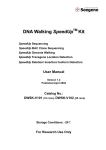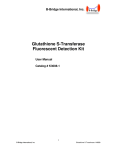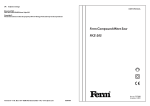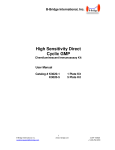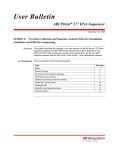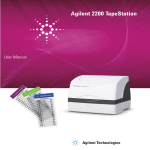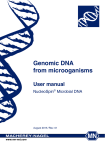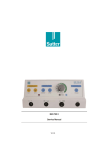Download Hibbett lab protocols for DNA isolation, PCR, and DNA sequencing.
Transcript
Hibbett lab protocols for DNA isolation, PCR, and DNA
sequencing.
Last update June, 2003.
Manfred Binder and David Hibbett
Introduction:
These basic protocols work well for our purposes. To optimize results for specific needs,
each laboratory should expect to make its own modifications (these protocols are
provided as a MSWord file so that you can easily make modifications). Some of the
following protocols originate from manufacturer’s manuals or other literature, which is
cited at the corresponding paragraphs (many protocols for molecular biology are
described in Maniatis T, Fritsch EF, Sambrook J. 1982. Molecular cloning: a laboratory
manual. Cold spring Harbor Laboratory, New York, U.S.A). Manufacturer’s manuals for
the complete sequencing cycle are available in the Hibbett lab (please make copies and
return the originals to our lab). In addition, answers to some FAQ’s are given and
suggestions how to coordinate the workflow and to streamline the sequencing process are
made. Please also read the document “ABI 377 DNA Sequencer use protocols”, which is
posted in N-301.
Contents:
1. DNA Extraction
2. PCR
3. Purification of PCR Products
4. Sequencing Reactions
5. Purifying the Sequencing product
6. ABI 377-XL Automated Sequencer Checklist
7. Chemicals and Reagents
1. DNA Extraction:
Our standard protocol is based on the following reference: Lee S, Taylor JW. 1990.
Isolation of DNA from fungal mycelia and single cells. In: Innis MA, Gelfand DH,
Sninsky JJ, White TJ (eds): PCR protocols, a guide to methods and applications. p 282287. Academic Press, San Diego, U.S.A.
This protocol is widely used and has many variations. We use this method to obtain DNA
from fungal material including fruiting bodies and cultures, dried herbarium specimens,
frozen samples, and freeze-dried material. It also works for many other sources.
Reagents:
•
•
•
•
•
•
•
Extraction buffer (EB)
Phenol-Chloroform (PC)
Chloroform-Isoamyl alcohol 24:1 (CI)
TE-buffer
3M Na-acetate pH 5.2
RNAse 10 mg/ml
95% and 70% EtOH
Tissue prep:
Cultured mycelium may be dried or fresh. In either case, harvest by filtration onto filter
paper with a Buchner funnel, wash with dH2O, remove agar inoculum block if present.
Scrape off mycelium growing on solid media using a sterile scalpel.
Fruiting body tissue may be dried or fresh. Scrape clean or cut away surface tissues. Use
approx. 20 mg from dried samples or 200 mg from fresh material.
Grinding / Extraction:
I. Samples may be ground dry or in liquid nitrogen. A pinch of sand helps with the
grinding.
II. Dried cultured mycelium and small, delicate dried fruiting body fragments are
best ground dry in an Eppendorf tube with blue pellet pestles. Grind dry, then add
about 500ul hot EB, place in 65C heat block. Leave pestle in sample and regrind
occasionally over15-60 min.
III. Large amounts of mycelium or larger or tougher fruiting bodies are best ground in
porcelain mortar with liquid nitrogen. Grind to fine powder. Can use small
amount of powdered mycelium for minipreps in eppie (as above, but omit
grinding with blue pestle during extraction) or larger amounts for maxiprep in oak
ridge / corex tubes. For maxiprep, add mycelium to oak ridge tube
(polypropylene, not polycarbonate) and add 5-10 ml hot EB. Place in 65C water
bath for 15-60+ min with occasional mixing.
IV. Add equal volume PC as EB. Mix several times to form emulsion. (If necessary,
transfer to corex tube at this point). Spin for 10 min in microfuge or Sorvall.
Carefully remove aqueous, upper layer (containing DNA) to a new tube.
V. Repeat IV, but this time use CI instead PC.
VI. Repeat V.
VII. Add 0.1 volumes 3M Na-acetate and 1.8 volumes cold 95% EtOH. Mix gently.
This can be done in polycarbonate.
VIII. If visible precipitate forms, spin down immediately, 5-10 min. If no DNA is seen,
put at –20 for 15+ min and then spin.
IX. Draw off EtOH. Add 70% EtOH (same volume as 95%) and mix gently for about
1 min. Draw off 70% or spin 5 min first and (air) dry DNA pellet.
X. Resuspend in 500 / 50 ul (maxiprep / miniprep) TE.
XI. Often, there are large amounts of RNA in the DNA solutions. If desired, the RNA
can be removed by a 50 min room temperature digestion with 0.01 volumes 10
mg/ml RNAse, followed by two CI extractions and EtOH precipitation.
2. PCR:
DNA prep:
The concentration of a DNA stock solution can be calculated by using a photometer at a
wave length of 260 nm (1 OD = 50 ug DNA/ml, Maniatis et al. 1982). Depending on
DNA quality, 5-50 ng DNA per PCR reaction are sufficient as a template. After making a
few but exact measurements run 5 ul samples on a 1% agarose gel with ethidium
bromide, compare the signal strength and use a picture of the gel to estimate DNA stocks
in the future. For PCR reactions, a small aliquot is usually diluted in dH2O in a range
from 1:10 to 1:3000. A typical reaction with a final volume of 25 ul looks like this:
•
•
•
•
•
•
•
15 ul dH20
2.5 ul 10x PCR buffer
5 ul DNA solution
0.5 ul dNTP mix
1.25 ul Primer A (= 12.5 pmol)
1.25 ul Primer B
0.125 Taq DNA Polymerase (5U/ul)
PCR programs:
Running PCR reactions on a thermocycler involves three major steps (denaturation,
annealing, extension), which are repeated in cycles. The annealing temperature is most
critical, because it depends on the melting point of the primes used. A simple rule of
thumb is to count 2 degrees Celsius for each A+T and 4C for each G+C in a primer
sequence and then substract 3C of the sum. This first approximation serves to further
optimize a PCR reaction. For a more elaborate melting point calculation see Maniatis et
al., 1982.
A program to run PCR reactions reads like this example:
1.
2.
3.
4.
5.
6.
7.
2 min 95C (initial denaturation)
1 min 94C denaturation
30 sec annealing at 50C
1 min extension at 72C
goto step 2 and repeat 30 cycles
5 min final extension at 72C
4C indefinite to stop the reaction, not for storage
The MJ Thermocycler performs several tasks including touch down PCR and ramps. The
MJ Research PTC-200 DNA Engine & PTC-225 DNA Engine Tetrad Operations
Manual. Version 3.7 (next to the thermocycler) is self-explanatory to set, save, and run
programs.
3. Purification of PCR Products
Prior to sequencing, PCR reactions need to be cleaned using specifically designed
cleaning kits. There is a variety of DNA cleaning kits to choose from and they all share
following rationale. DNA is bound to a silica matrix (liquid stage or stationary in a spin
column) in high salt concentration, washed in EtOH, and eluted in low salt concentration,
usually dH2O. This way, not only undesirable remnants of the PCR reaction itself can be
removed. Cleaning kits also do a great job purifying crude DNA stock solutions
removing proteins, polysaccharides, and even pigments. We use the BIO 101 GeneClean
kit for both purposes. Designed to retrieve DNA from agarose gels, the protocol allows to
get in through the back door having a liquid DNA sample at hand. (BIO 101 Guide to
Protocols and Procedures, at the shelf that divides PCR- and Sequencing-Bench).
I.
II.
III.
IV.
transfer the PCR reaction in a 1.5 ml tube, add 3 volumes NaI and mix.
add 5 ul glassmilk, mix and allow the DNA to bind for 5 min.
spin down a Vmax for 5 sec, remove and keep supernatant separately.
wash the DNA/glassmilk pellet 2x with 500 ul NewWash, use a pipet to dissolve
the pellet completely.
V. spin down at Vmax for 5 sec each washing step.
VI. dissolve pellet in 20 – 35 ul H2O (weak – strong PCR product) for 5 min.
VII. spin down Vmax at 30 sec, transfer supernatant (clean PCR product) in a new tube
and freeze until used for sequencing.
4. Sequencing Reactions
In the course of a PCR reaction the product is exponentially accumulated. A sequencing
reaction is a very similar but straight-line (linear) reaction, since only one primer is used.
Instead of yielding in a number of nanomoles, sequencing products are yielding in
femtomol range. Flurescent dye molecules enable the sequencers detect unit to read those
miniscule amounts of DNA on a sequencing gel. Huge dye molecules are coupled with a
well-defined number of dNTP’s in a regular dNTP mix, replacing the terminal hydroxyl
group at the nucleotide. The modified nucleotides, of which A,T,G,C carry specific dye
molecules, are also called “dye terminators”. During an extension of a template, the DNA
polymerase requires the terminal OH group to incorporate the next nucleotide. The
incorporation of a dye terminator therefore defines the length of a new DNA fragment in
the current cycle of a sequencing reaction. Statistically, dye terminators are incorporated
several times at each base position of the template (PCR product, plasmid DNA, etc.)
during cycle sequencing. A ready sequencing reaction represents a mixture of terminated
fragments, which are labelled with one of the four dye molecules at a time. The
fragments are separated on a sequencing gel via electrophoresis according to their length.
Once a dye molecule passes the laser beam it will emit flurescent light at a specific wave
length. A photomultiplier records and digitizes signals, which are saved in a gel file by
the ABI collection software (ABI Prism 377 DNA Sequencer User’s Manual, in the shelf
above the sequencer).
The ABI PRISM BigDye Terminator Cycle Sequencing Ready Reaction Kit Protocol (at
the Sequencing-Bench) provides some general information how to set up, run, and clean
sequencing reactions. Our sequencing cocktail includes:
•
•
•
•
•
•
8.5 ul H2O
3 ul 5 x reaction buffer
3 ul PCR product (20-80 ng)
3 ul Primer (= 6 pmol)
0.5 ul Pellet Paint
2 ul* BigDye v1.1 (includes 2.5 x reaction buffer)
a total volume of 20 ul per reaction. *(To sequence longer fragments use up to 4 ul
BigDye).
Setting a program for the sequencing reaction requires an extended extension time that
allows the AmpliTaq DNA polymerase to incorporate “gigantic” dye terminators.
1.
2.
3.
4.
5.
6.
2 min 95C initial denaturation
1 min 94C denaturation
30 sec 50C annealing
4 min 72C extension
goto 2 and repeat 25 cycles
4C indefinite to stop the reaction (not for storage)
5. Purifying the Sequencing Product
We add 0.5 ul Pellet Paint (Novagen) to a sequencing reaction. Its sole eligibility is
staining the pellet blue, which actually makes it easier to handle. The cleaning procedure
we use is modified from the ABI PRISM BigDye Terminator Cycle Sequencing Ready
Reaction Kit v1.0 protocol p. 27.
I.
II.
III.
IV.
V.
VI.
VII.
VIII.
IX.
transfer sequencing reaction in a 1.5 ml tube.
add 5 ul of 125 mM EDTA and 60 ul 100% EtOH (200 proof).
close the tubes and mix by inverting.
leave tubes at room temperature or at –18C for <30 min to precipitate. Do not
exceed precipitation >24 hours. (You have to find out what works best for you).
This will increase the precipitation of unincorporated dye terminators (visible
“dye blobs” in the gel file).
spin samples at Vmax for 10 min and aspirate the supernatents immediately.
wash pellets 2x adding 250 ul 70% EtOH and spinning them down at Vmax for 5
min.
remove the supernatants carefully.
air-dry pellets 15-20 min, do not overdry pellets.
the samples should be stored in this condition at –18C. Add 2-3 ul loading dye,
dissolve the pellets and denaturate them shortly before a sequencing run.
6. ABI 377-XL Automated Sequencer Checklist
Please read and follow the “ABI 377 DNA Sequencer use protocols” document that is
posted in N-301.
Ask your advisor to introduce you to the Hibbett Lab, meet the people there and simply
get familiar with the shared facility. Write an e-mail to David to get on the ABI
Sequencer User’s list to receive news and updates. Make an appointment with the local
expert (LE) in your lab to schedule the first sequencing run. The LE will lead you
through the whole process. Plan a whole day for the first sequencing run to have plenty of
time to ask questions and make helpful notes. Sequencing involves numerous steps but it
is not particularly difficult. You will be able to run the next sequencing gel under your
LE’s supervision, handling most of the work yourself. After a couple of runs under
supervision you should be an expert on the ABI 377-XL Automated Sequencer.
However, if you are not feeling confident ask your LE for more supervision and find
opportunities to watch your colleagues run their gels. If there is no LE in your lab, come
talk to David or Manfred and we will find a way for you to get training.
Gel mixture:
The composition of a sequencing gel is adjusted to sequencer type, length of the gel, and
loading dye composition, which includes formamide in our case. Half the quantity
recommended in the FMC Long Ranger Gel Solution. Manual DNA Sequencing (at the
scale bench) is plenty to poor the polyacrylamide gel.
•
•
•
•
13 ml dH2O
9g Urea
2.5 ml 10x TBE buffer
2.5 ml Long Ranger 50% ready mix
Stir the solution until all the urea is dissolved. Then filter it using the magnetic membrane
filter system and a 0.2 um Supor-200 membrane filter. Then add
• 17.5 ul TEMED
• 125 ul fresh 10% APS solution
Stir and polymerization begins. There is enough time to poor the gel (3-4 min).
The LE’s will demonstrate how to assemble glass plates and spacers on the sequencing
gel caster (Otter) and help to poor the gel. After the precomb is in it takes about 2 hours
for complete polymerization. Remove the precomb, clean the well area thoroughly and
put in the shark-tooth comb. For additional information check the ABI Prism 377 DNA
Sequencer User’s Manual (in the shelf above the sequencer). The whole sequencing run
process is described in there very detailed.
All the sequencing equipment has modular design, meaning there is only one way to
assemble a sequencing run. For example, if the glass plates are assembled in the wrong
orientation, they do not fit into the sequencer. This mechanism prevents running the
sequencer with the wrong setup. Use the following checklist and complete it with
personal notes to handle the sequencing process with confidence.
ABI 377 Checklist (first update since 2000)
1. Turn on sequencer, then start the computer. If computer is already on, restart.
2. Place lower buffer chamber in machine, then place gel in gel cassette and place that in
the machine and close the door.
3. On the computer, click the ABI Prism 377XL Collection icon (desktop) to launch the
data collection program.
4. Pull down the File menu, select New, then click on the “Sequence Run” icon. This
will open the Run Window.
5. Select a Plate Check Module (use the default or you may use any Plate Check
Module) and then click Plate Check. The Scan Window will open and the scan lines
will appear in a minute or two (if they don’t appear, restart the Mac and start over).
The scan lines should be mostly flat. If they are not, then use the compressed air to
disloge dust from the plates.
6. Attach upper buffer chamber and the heat dissipation plate. Be sure to connect all
leads and the coolant hoses. Make sure that the gel and the gasket on the upper buffer
chamber are clean.
7. Gently, gradually fill the upper buffer chamber with 1x TBE buffer. There should be
no leaks. If there are ANY leaks, abort and start over.
8. Fill the lower buffer chamber. Use a syringe with a bent needle to gently flush the
bubbles from the gap between the glass plates (you can’t get every last one).
9. Use a syringe with a fine gauge needle to clean the wells. Here you are mostly
concerned with removing bubbles. Place the cover on the upper buffer chamber.
10. Pull down the File menu and select New then click on the “Sequence Sample” icon.
This will open a new Sample Sheet.
11. Enter your sample data in the Sample Sheet. If you are running BigDye (default), then
the DyeSet/Primer field should read DT {BD Set Any – Primer}. If it does not, then
select by clicking the arrow in that field.
12. Select Save As from the File pull-down menue and save your Sample Sheet. Use an
obvious name like “Denis2/1/00”.
13. Close the Sample Sheet and return to the Run Window. (To save some time it is
convenient to prepare a Sample Sheet during the pre-run, described next).
14. Select a pre-run module (or use the default) and prerun the gel for up to one hour.
You can usually get away with a much shorter pre-run, however. The gel temperature
should be at 51C when you start the run.
15. After starting the pre-run, go to the Status Window and check to make sure that the
laser and electrophoresis power and timer are running.
16. Go to the Run Window and press Pause.
17. Clean the wells again. Now you want to get rid of excess urea as well as any bubbles
that remain.
18. Load the ODD lanes only. For a 48-lane run, load 1.5-1.9 ul per lane.
19. Return to the Run Window and press resume. Check the Status Window to be sure
that the electrophoresis power is running.
20. After 2-3 minutes, press Pause and clean the empty wells again. Load the EVEN
lanes. Replace the cover on the upper buffer chamber.
21. On the Run Window, press Cancel. This will end the pre-run.
22. In the Run Window, select the following (default):
Run Module: Seq Run 36E-1200 is a 7 hour run at 1200 scans/hour (default setting),
Seq Run 36E-2400 is a 3.5 hour run at 2400 scans/hour.
Sample Sheet: Select your sample sheet
Lanes: for now, this will be 48 lanes
Run Mode: for 48 lanes use full “XL Scan”, for 36 lanes use “Full Scan”.
Well-to-well distance: 36 cm.
23. Click Run. Check the Status Window to make sure that power is on and that timer is
working correctly. Check the scan window to make sure that scan lines appear.
After the run is finished the ABI Prism 377XL Collection software creates a gel file. You
will learn how to track and extract lanes, transfer the sequences to your computer, etc.
(detailed info in the ABI Prism 377 DNA Sequencer User’s Manual, in the shelf above
the sequencer). For several reasons, it is important to extract your data right after the
sequencer is cleaned. Use the Abi21-PC computer, which is a part of the sequencer, to
access your computer via Apple Talk and transfer the data. Shut down the Abi21-PC, this
will clear the memory for the next run. Do not use the Abi21-PC during an ongoing
sequencing run or try to access it from your computer. A sequencing run is very memory
intensive. If the Abi21-PC freezes, then no data will be collected. Run folders older than
one month will be deleted for lack of space on the hardisk.
Notes on sequencing etiquette:
Sharing: Sharing of gels is encouraged, but it is also fine to run a gel with only a few
samples. When you sign up for a run, indicate the number of free lanes in the Sign-up
Sheet at the sequencer. People who share a gel should share the work (e.g., one person
pours the gel, the other takes the gel down and cleans the plates; or one person sets up
one run, the other sets up the next run). If the person with whom you are sharing a gel
does not show up at the agreed time, just go ahead and run your own samples. Don’t feel
obliged to load other people’s samples; if the run has problems, you don’t want to have to
explain the poor results the next day.
Supplies and maintenance: Check the shared facility in N-301 the day before you actually
run a gel to make sure everything you need is ready for use. Do not feel obliged to clean
up after others. If necessary, ask the person who ran the sequencer last to clean dirty
equipment or to assist you finding missing equipment. Call attention to supplies that are
running low and alert Manfred if anything is missing.
7. Chemicals and Reagents
•
•
•
•
•
•
•
Extraction buffer (EB): 0.15 M NaCl, 50 nM Tris (pH 8.0), 50 mM EDTA, 1%
SDS.
Phenol-Chloroform (PC) ready mix
Chloroform-Isoamyl alcohol 24:1 (CI) ready mix
TE buffer: 10mM Tris Base, 1 mM EDTA, pH 8.5
3M Na-acetate pH 5.2
RNAse 10 mg/ml
95% and 70% EtOH
10x TBE buffer (FMC Long Ranger Gel Solution. Manual DNA Sequencing at the
scale):
• 890mM Tris Base
108 g
• 890 mM Boric Acid 55 g
7.44 g
• 20 mM Na2EDTA
Add ultrapure H2O to a final volume of 1000 ml, mix thoroughly and filter through <
0.45 filter membrane (Whatman). Check pH, it should be about 8.3. Do not adust the pH
and start over if necessary! Addition of acid and alkaline solutions (e.g., HCl or NaOH)
will alter the gel’s physical properties dramatically. Prepare a new solution weekly as
precipitation will soon occur. Take nine parts of dH2O and one part of 10x TBE to get a
1x TBE buffer (a 1:10 dilution).
Loading buffer 5+1 for Seq gels:
add 25 mM EDTA to a 50 mg/ml Blue Dextran solution. Store at 4C. Take one part of
this solution and mix it with 5 parts deionized formamide to get the loading dye for
sequencing gels.











